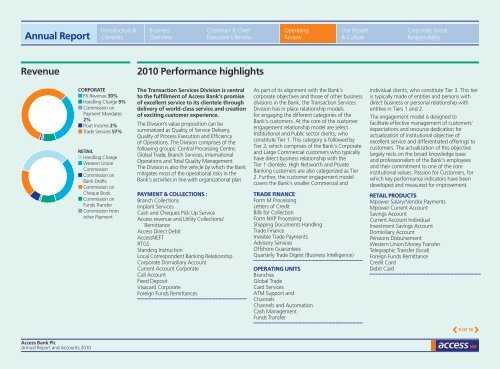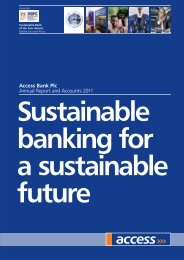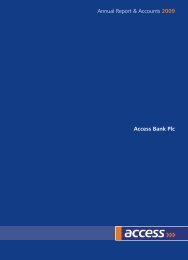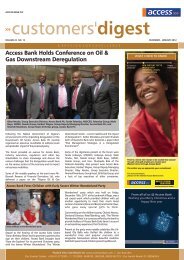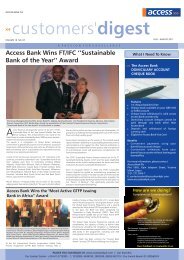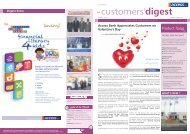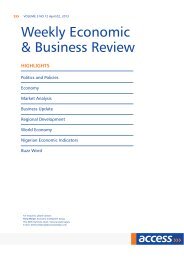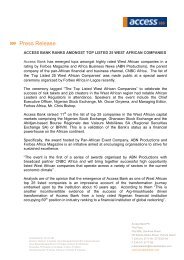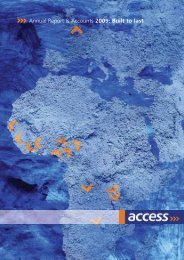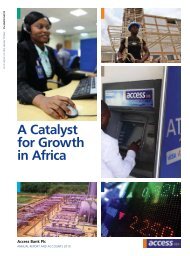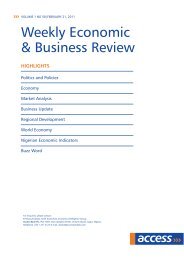2010 Access Bank Annual Report and Accounts
2010 Access Bank Annual Report and Accounts
2010 Access Bank Annual Report and Accounts
Create successful ePaper yourself
Turn your PDF publications into a flip-book with our unique Google optimized e-Paper software.
<strong>Annual</strong> <strong>Report</strong><br />
Introduction & Business Chairman & Chief Operating Our People Corporate Social<br />
Contents Overview Executive’s Review Review & Culture Responsibility<br />
Revenue<br />
<strong>2010</strong> Performance highlights<br />
Corporate<br />
FX Revenue 30%<br />
H<strong>and</strong>ling Charge 9%<br />
Commission on<br />
Payment M<strong>and</strong>ates<br />
2%<br />
Float Income 2%<br />
Trade Services 57%<br />
RETAIl<br />
H<strong>and</strong>ling Charge<br />
Western Union<br />
Commission<br />
Commission on<br />
<strong>Bank</strong> Drafts<br />
Commission on<br />
Cheque Book<br />
Commission on<br />
Funds Transfer<br />
Commission from<br />
other Payment<br />
The Transaction Services Division is central<br />
to the fulfillment of <strong>Access</strong> <strong>Bank</strong>’s promise<br />
of excellent service to its clientele through<br />
delivery of world-class service <strong>and</strong> creation<br />
of exciting customer experience.<br />
The Division’s value proposition can be<br />
summarized as Quality of Service Delivery,<br />
Quality of Process Execution <strong>and</strong> Efficiency<br />
of Operations. The Division comprises of the<br />
following groups: Central Processing Centre,<br />
Global Trade, Branch Services, International<br />
Operations <strong>and</strong> Total Quality Management.<br />
The Division is also the vehicle by which the <strong>Bank</strong><br />
mitigates most of the operational risks in the<br />
<strong>Bank</strong>’s activities in line with organizational plan.<br />
PAYMENT & COLLECTIONS :<br />
Branch Collections<br />
Implant Services<br />
Cash <strong>and</strong> Cheques Pick Up Service<br />
<strong>Access</strong> revenue <strong>and</strong> Utility Collections/<br />
Remittance<br />
<strong>Access</strong> Direct Debit<br />
<strong>Access</strong>NEFT<br />
RTGS<br />
St<strong>and</strong>ing Instruction<br />
Local Correspondent <strong>Bank</strong>ing Relationship<br />
Corporate Domiciliary Account<br />
Current Account Corporate<br />
Call Account<br />
Fixed Deposit<br />
Visacard Corporate<br />
Foreign Funds Remittances<br />
As part of its alignment with the <strong>Bank</strong>’s<br />
corporate objectives <strong>and</strong> those of other business<br />
divisions in the <strong>Bank</strong>, the Transaction Services<br />
Division has in place relationship models<br />
for engaging the different categories of the<br />
<strong>Bank</strong>’s customers. At the core of the customer<br />
engagement relationship model are select<br />
Institutional <strong>and</strong> Public sector clients, who<br />
constitute Tier 1. This category is followed by<br />
Tier 2, which comprises of the <strong>Bank</strong>’s Corporate<br />
<strong>and</strong> Large Commercial customers who typically<br />
have direct business relationship with the<br />
Tier 1 clientele. High Networth <strong>and</strong> Private<br />
<strong>Bank</strong>ing customers are also categorized as Tier<br />
2. Further, the customer engagement model<br />
covers the <strong>Bank</strong>’s smaller Commercial <strong>and</strong><br />
TRADE FINANCE:<br />
Form M Processing<br />
Letters of Credit<br />
Bills for Collection<br />
Form NXP Processing<br />
Shipping Documents H<strong>and</strong>ling<br />
Trade Finance<br />
Invisible Trade Payments<br />
Advisory Services<br />
Offshore Guarantees<br />
Quarterly Trade Digest (Business Intelligence)<br />
OPERATING UNITS<br />
Branches<br />
Global Trade<br />
Card Services<br />
ATM Support <strong>and</strong><br />
Channels<br />
Channels <strong>and</strong> Automation<br />
Cash Management<br />
Funds Transfer<br />
Individual clients, who constitute Tier 3. This tier<br />
is typically made of entities <strong>and</strong> persons with<br />
direct business or personal relationship with<br />
entities in Tiers 1 <strong>and</strong> 2.<br />
The engagement model is designed to<br />
facilitate effective management of customers’<br />
expectations <strong>and</strong> resource dedication for<br />
actualization of institutional objective of<br />
excellent service <strong>and</strong> differentiated offerings to<br />
customers. The actualization of this objective<br />
largely rests on the broad knowledge base<br />
<strong>and</strong> professionalism of the <strong>Bank</strong>’s employees<br />
<strong>and</strong> their commitment to one of the core<br />
institutional values: Passion for Customers, for<br />
which key performance indicators have been<br />
developed <strong>and</strong> measured for improvement.<br />
RETAIL PRODUCTS<br />
Mpower Salary/Vendor Payments<br />
Mpower Current Account<br />
Savings Account<br />
Current Account Individual<br />
Investment Savings Account<br />
Domiciliary Account<br />
Pensions Disbursement<br />
Western Union Money Transfer<br />
Telegraphic Transfer (local)<br />
Foreign Funds Remittance<br />
Credit Card<br />
Debit Card<br />
9 OF 10<br />
<strong>Access</strong> <strong>Bank</strong> Plc<br />
<strong>Annual</strong> <strong>Report</strong> <strong>and</strong> <strong>Accounts</strong> <strong>2010</strong>


